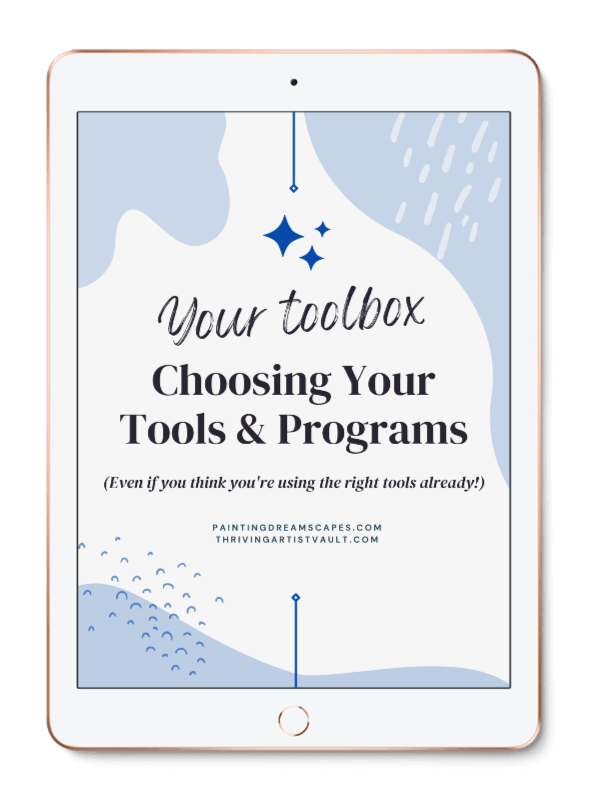“No idea”. That was my answer whenever someone would ask me how much money I made from my art on a given month. For the longest time, I never tracked any of my stats and I never had any knowledge over my finances and it was a big mistake. In this post I’m going to show you the 5 key stats you need to track if you want to make a living from your art.

WHY YOU’RE NOT TRACKING YOUR STATS
If you’re not tracking these important metrics in your business, chances are it’s not because you forgot. It’s not because you didn’t care either. You do.
That’s exactly why you’re not tracking them.
It’s very hard, crushing almost, to track stats that are far from ideal. When the month ends and you look back to how much you made that month and you see a very small figure. Or how much you spent and you see a big one.
It’s very disheartening. Especially in the beginning.
So you put it off. You make up reasons why you won’t track your stats. After all, who enjoys putting this face on a monthly basis?

But that’s the very reason why you need to track them.
WHY SHOULD YOU TRACK YOUR STATS (EVEN WHEN IT FEELS THERE’S NOTHING TO TRACK)?
Keep tabs on the health of your business
Without knowing your income, expenses and other stats, you’re turning a blind eye to your business’ health. You could be going into debt without knowing it, or be on the verge of needing a day job.
You need to track these stats and evaluate them at least on a monthly basis to see how your career as an artist is going and make adjustments as needed. You’ll also be able to see patterns over time (ie. summer season may be slower for business and you can find new ways to get over the summer slump) and prepare for them.
If you don’t take care of your art business/career, you may find yourself without one soon enough!
It's essential to report your income + taxes
This goes without saying, but you should be reporting your income and paying taxes if you make a living through your art. If you’re required by your country’s laws to report your income to the proper authority and pay taxes on that income, it’ll be pretty hard to do so if you’re not tracking that info at all.
It pushes you to work harder to see them go up rather than down
This may seem counterintuitive and you probably think seeing your stats will actually make you lose all motivation, but it’s not true. When you see stats that aren’t what you’d like them to be, it’ll light up a fire under your bum to get to work, find some clients, make some sales.
You’ll do whatever it takes to make those stats go up next month!

It’s a graphic representation of your success
Closely related to the previous one, once your stats begin to grow and be positive, you’ll be able to look back and see your hard work paying off. The boost in confidence and self-esteem you get when you see your results getting better and better is unparalleled.
If you ever wondered ‘Am I really making any progress?’, these stats will hold the answer you long for: yes!
Shuts the 'Naysayers' up
The sweetest reason of them all. When you track your stats and you see that your hard work is paying off and you’re making a living from your art, you’ll be able to shush the naysayers.
Whenever the next Joe rolls around telling you art isn’t a real job, you’ll have the numbers to back you up!
Glorious.
WHICH STATS SHOULD YOU TRACK?
These are the most important stats you should track for the aforementioned reasons. Let’s dive in!
1. Monthly income
I mean, duh, right? But you’d be surprised how many artists out there don’t keep track of their income. If you’re also in the same boat, chances are it’s because you subconsciously fear looking at the picture your stats are painting.
A picture of an artist who isn’t able to make a living from your art.
But, truth is, the more you avoid looking at your stats, the worse you’ll do financially.
Track your monthly income on the first day of the month and write down any important notes or takeaways from it.
TRACK YOUR MONTHLY INCOME & REVENUE
Track your monthly income on the first day of the month and write down any important notes or takeaways from it.
Did you reach your revenue goal? If not, what can you do next month to ensure you hit it?
Did your income increase this month? Can you find out what caused your income to grow so that you can replicate it next month?
2. Monthly expenses
If tracking your income was already challenging, tracking your expenses is likely to make you want to crawl under a rock.
When you don’t have a clear grasp of how much you’re earning and, how much you can spend, you tend to overspend. So when you look at your monthly expenses, you start questioning your life choices.
The first one you question? Why you decided to track your expenses in the first place!
But, there’s a special kind of power that comes with having total control and knowledge over your money + finances. You can make better decisions and continue spending your money, just wisely this time!
TRACKING YOUR MONTHLY EXPENSES
Track your expenses on the first day of the month. You can categorize them under personal and business categories to be able to tell between both.
Are you spending more than you earn?
Check your expenses to cut out anything that isn’t absolutely necessary
Are you spending your money on things that are likely to give you a return on your investment (ie. A graphics tablet that makes drawing commissions faster so you can earn more) vs expenses that don’t (ie. A new high definition TV)?
Strive to spend your money on tools, courses or other items that can give you benefits in the future.
BONUS TIP
Once you know what your average revenue per month is, you can create a budget for your monthly spending. That way, you won’t overspend and you’ll have a healthier business + you won’t go into debt.
3. Audience growth on social media
This is one you’re probably checking often. It’s easy to fall for the trap of constantly checking your follower counts, pageviews and other stats that make you feel good.
But don’t let it consume you. Growing your audience is essential but don’t give numbers too much power over you. If you feel crushed whenever you lose a follower, it’s time to take a step back.
You need to track your audience growth once a month as well. This will let you keep track of your growth without obsessing over numbers and their daily fluctuations.
Tracking your audience growth gives you a clear picture of how much people are enjoying your content. It's also a great metric to refer when you're trying new strategies and you need to see if they worked or not.
TRACKING YOUR AUDIENCE GROWTH
Track your audience growth on each of your social media or online platforms on the first day of the month.
Track the number of followers you have, how many views you received and which artworks/pages/videos received the most attention each month
Is any artwork/video/content type gaining more attention than the rest? Create similar content to attract even more people to your content!
4. Number of orders + order value
This is important if you’re selling commissions or merchandise. Tracking the number of orders along with the average order value will tell you how your business is doing.
The number of orders will indicate how much work you received but also what your limit is. If you notice you regularly can’t accept more than X number of orders, you’ll have found your ceiling and you won’t be able to scale your income until you break it.
That’s where the order value comes in and plays a key role.
Knowing the average order value can tell you things like:
- How much you’re making per artwork or order sold. If this number is low, it means you’ll need to complete many orders to make a decent income. And, I’m not sure about you, but I don’t want to work my bum off for pennies…
- What kind of clientele you're attracting. If you have items for sale at small and high prices, and you notice your average order value is small, it means you’re attracting an audience that doesn’t value what you sell or that you’re not doing a good job at making your high-end services look valuable to your audience.
- When to raise your prices. If you’re getting a lot of orders from clients but the revenue per order is small, it’s a good indication that you need to raise your prices. Increasing your rates will reduce the number of orders you need to complete to reach your revenue goal.
Since many clients won’t want to pay your new prices, you’ll transition into working with clients who value you and are willing to pay what you’re worth. Which means you’ll be working with dream clients who value you, earning more money and working less. #Win
TRACKING YOUR ORDERS & AVERAGE ORDER VALUE
Track how many orders you receive each month and how much each one cost
Sum the values of all of the orders you've received in the last month and divide it by the number of orders you received. This is your average order value.
Is any artwork/video gaining more attention than the rest? Create similar content to attract even more people to your gallery!
5. Conversion rates
Depending on what you offer, this may not be easy to track or applicable. Conversion rates tell you how many of your visitors actually purchased something from your store or commissioned you.
Why is this stat important?
It can give you insights on which part of your system isn't working as smoothly as it should. If you have 1,000 people check out your commission information but only 1 client hires you, you know there's something wrong with your offer or the way you're presenting your services to potential clients.
On the other hand, if you have 5 people check out your commissions and no one buys, chances are you need to bring more people to your commission page to get sales rolling.
You should aim to have at least a 2% conversion rate on your products or services, so for each 100 people that check you out, at least 2 should hire you or buy from you.
To track this stat (also once a month) you’ll need to track how many people visited your commission page or your store, and divide it by the number of clients or customers that bought from you.
TRACKING YOUR CONVERSION RATES
Track how many people checked out your commission information or your store that month
Divide it by the number of clients or customers you had that month. That is your conversion rate!
Is your conversion rate below 2%? Determine if you need to improve your offer or attract more potential clients to your page.
IN CONCLUSION...
Tracking your stats is important to make sure you stay on the right track to growing your audience and making a living from your art.
You want to track your income, expenses, audience growth, sales + order value and your conversion rates.
Are you tracking your stats? If not, how do you think starting now would help you grow your audience and income as an artist? Let me know in the comments below!






0 comments